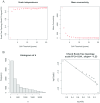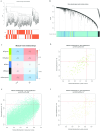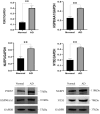Identification of immunogenic cell death-related genes involved in Alzheimer's disease
- PMID: 38360834
- PMCID: PMC10869701
- DOI: 10.1038/s41598-024-54357-6
Identification of immunogenic cell death-related genes involved in Alzheimer's disease
Abstract
Alzheimer's disease (AD) is the leading cause of dementia worldwide, with recent studies highlighting the potential role of immunogenic cell death (ICD) in the pathogenesis of this neurodegenerative disorder. A total of 52 healthy controls and 64 patients with AD were included. Compared to the controls, the patients with AD exhibited 2392 differentially expressed genes (DEGs), of which 1015 and 1377 were upregulated and downregulated genes, respectively. Among them, nine common genes were identified by intersecting the AD-related module genes with the DEGs and ICD-associated genes. Gene ontology (GO)analysis further revealed "positive regulation of cytokine production" as the most significant term. Moreover, the enriched molecular functions were primarily related to the inflammatory body complex, while the overlapping genes were significantly enriched in lipopolysaccharide binding. Kyoto encyclopedia of genes and genomes (KEGG) analysis also indicated that these overlapping genes were mainly enriched in immunity, inflammation, and lipid metabolism pathways. Furthermore, the following four hub genes were detected using machine learning algorithms: P2RX7, HSP90AA1, NT5E, and NLRP3. These genes demonstrated significant differences in expression between the AD and healthy control groups (P < 0.05). Additionally, the area under the curve values of these four genes were all > 0.7, indicating their potential diagnostic value for AD. We further validated the protein levels of these four genes in the hippocampus of 3xTg-AD and C57BL/6J mice, showing P2RX7 and HSP90AA1 expression levels consistent with the previously analyzed trends. Finally, the single-sample gene set enrichment analysis (ssGSEA) algorithm provided additional evidence by demonstrating the crucial role of immune cell infiltration and its link with the hub genes in AD progression. Our study results suggest that ICD-mediated elevation of HSP90AA1 and P2RX7 levels and the resulting induction of tau hyperphosphorylation and neuroinflammation are vital in the AD pathogenic mechanism.
Keywords: Alzheimer’s disease; GEO; Immunogenic cell death; WGCNA.
© 2024. The Author(s).
Conflict of interest statement
The authors declare no competing interests.
Figures










Similar articles
-
Bioinformatics analysis of diagnostic biomarkers for Alzheimer's disease in peripheral blood based on sex differences and support vector machine algorithm.Hereditas. 2022 Oct 4;159(1):38. doi: 10.1186/s41065-022-00252-x. Hereditas. 2022. PMID: 36195955 Free PMC article.
-
Identification and validation of oxidative stress and immune-related hub genes in Alzheimer's disease through bioinformatics analysis.Sci Rep. 2023 Jan 12;13(1):657. doi: 10.1038/s41598-023-27977-7. Sci Rep. 2023. PMID: 36635346 Free PMC article.
-
Identification of mitochondrial related signature associated with immune microenvironment in Alzheimer's disease.J Transl Med. 2023 Jul 11;21(1):458. doi: 10.1186/s12967-023-04254-9. J Transl Med. 2023. PMID: 37434203 Free PMC article.
-
Identification of diagnostic genes for both Alzheimer's disease and Metabolic syndrome by the machine learning algorithm.Front Immunol. 2022 Nov 2;13:1037318. doi: 10.3389/fimmu.2022.1037318. eCollection 2022. Front Immunol. 2022. PMID: 36405716 Free PMC article.
-
Identification of common core ion channel genes in epilepsy and Alzheimer's disease.Ir J Med Sci. 2024 Feb;193(1):417-424. doi: 10.1007/s11845-023-03447-x. Epub 2023 Jul 21. Ir J Med Sci. 2024. PMID: 37477849 Review.
Cited by
-
Neuroinflammation mediates the progression of neonate hypoxia-ischemia brain damage to Alzheimer's disease: a bioinformatics and experimental study.Front Aging Neurosci. 2025 Jan 13;16:1511668. doi: 10.3389/fnagi.2024.1511668. eCollection 2024. Front Aging Neurosci. 2025. PMID: 39872979 Free PMC article.
-
Analysis of immunogenic cell death in periodontitis based on scRNA-seq and bulk RNA-seq data.Front Immunol. 2024 Nov 1;15:1438998. doi: 10.3389/fimmu.2024.1438998. eCollection 2024. Front Immunol. 2024. PMID: 39555084 Free PMC article.
References
-
- 2021 Alzheimer's disease facts and figures. Alzheimer's Dement.17, 327–406. 10.1002/alz.12328 (2021). - PubMed
MeSH terms
Grants and funding
LinkOut - more resources
Full Text Sources
Medical
Molecular Biology Databases
Research Materials
Miscellaneous

